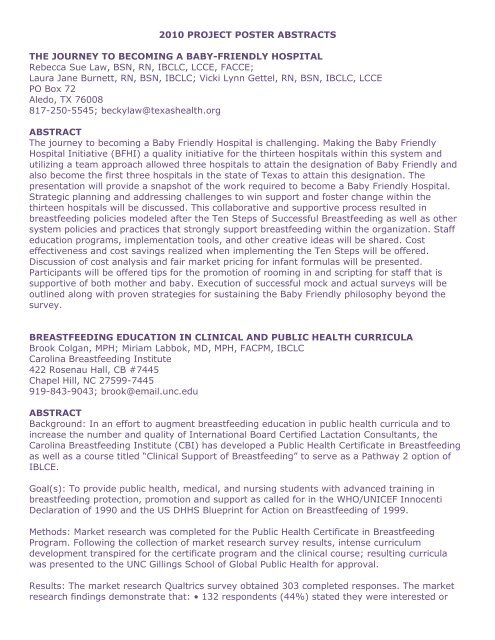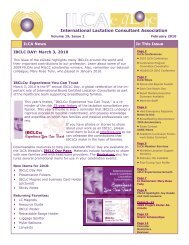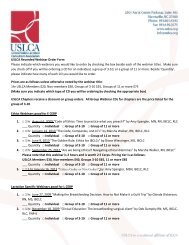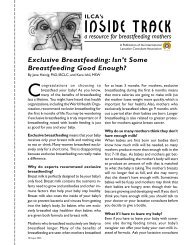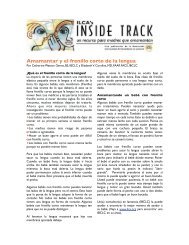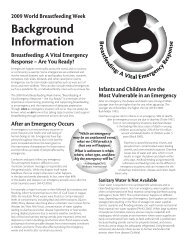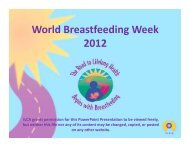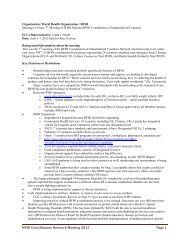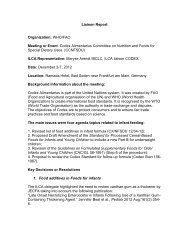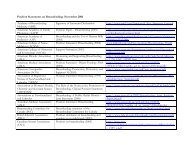2010 - International Lactation Consultant Association
2010 - International Lactation Consultant Association
2010 - International Lactation Consultant Association
You also want an ePaper? Increase the reach of your titles
YUMPU automatically turns print PDFs into web optimized ePapers that Google loves.
<strong>2010</strong> PROJECT POSTER ABSTRACTS<br />
THE JOURNEY TO BECOMING A BABY-FRIENDLY HOSPITAL<br />
Rebecca Sue Law, BSN, RN, IBCLC, LCCE, FACCE;<br />
Laura Jane Burnett, RN, BSN, IBCLC; Vicki Lynn Gettel, RN, BSN, IBCLC, LCCE<br />
PO Box 72<br />
Aledo, TX 76008<br />
817-250-5545; beckylaw@texashealth.org<br />
ABSTRACT<br />
The journey to becoming a Baby Friendly Hospital is challenging. Making the Baby Friendly<br />
Hospital Initiative (BFHI) a quality initiative for the thirteen hospitals within this system and<br />
utilizing a team approach allowed three hospitals to attain the designation of Baby Friendly and<br />
also become the first three hospitals in the state of Texas to attain this designation. The<br />
presentation will provide a snapshot of the work required to become a Baby Friendly Hospital.<br />
Strategic planning and addressing challenges to win support and foster change within the<br />
thirteen hospitals will be discussed. This collaborative and supportive process resulted in<br />
breastfeeding policies modeled after the Ten Steps of Successful Breastfeeding as well as other<br />
system policies and practices that strongly support breastfeeding within the organization. Staff<br />
education programs, implementation tools, and other creative ideas will be shared. Cost<br />
effectiveness and cost savings realized when implementing the Ten Steps will be offered.<br />
Discussion of cost analysis and fair market pricing for infant formulas will be presented.<br />
Participants will be offered tips for the promotion of rooming in and scripting for staff that is<br />
supportive of both mother and baby. Execution of successful mock and actual surveys will be<br />
outlined along with proven strategies for sustaining the Baby Friendly philosophy beyond the<br />
survey.<br />
BREASTFEEDING EDUCATION IN CLINICAL AND PUBLIC HEALTH CURRICULA<br />
Brook Colgan, MPH; Miriam Labbok, MD, MPH, FACPM, IBCLC<br />
Carolina Breastfeeding Institute<br />
422 Rosenau Hall, CB #7445<br />
Chapel Hill, NC 27599-7445<br />
919-843-9043; brook@email.unc.edu<br />
ABSTRACT<br />
Background: In an effort to augment breastfeeding education in public health curricula and to<br />
increase the number and quality of <strong>International</strong> Board Certified <strong>Lactation</strong> <strong>Consultant</strong>s, the<br />
Carolina Breastfeeding Institute (CBI) has developed a Public Health Certificate in Breastfeeding<br />
as well as a course titled “Clinical Support of Breastfeeding” to serve as a Pathway 2 option of<br />
IBLCE.<br />
Goal(s): To provide public health, medical, and nursing students with advanced training in<br />
breastfeeding protection, promotion and support as called for in the WHO/UNICEF Innocenti<br />
Declaration of 1990 and the US DHHS Blueprint for Action on Breastfeeding of 1999.<br />
Methods: Market research was completed for the Public Health Certificate in Breastfeeding<br />
Program. Following the collection of market research survey results, intense curriculum<br />
development transpired for the certificate program and the clinical course; resulting curricula<br />
was presented to the UNC Gillings School of Global Public Health for approval.<br />
Results: The market research Qualtrics survey obtained 303 completed responses. The market<br />
research findings demonstrate that: • 132 respondents (44%) stated they were interested or
very interested in the proposed certificate • 61 respondents (20%) stated that they would apply<br />
now for the certificate if it were available. The clinical course is currently half-way through the<br />
first semester and feedback will be collected from students for quality improvement. Results<br />
from the course evaluation will be presented.<br />
Conclusion(s): This poster will include a brief presentation of the certificate and clinical course as<br />
well as ideas for additional implementation of breastfeeding in graduate health education and<br />
medical training.<br />
IMPROVING BREASTMILK FEEDING RATES AT DISCHARGE FROM NICU: STAFF<br />
EDUCATION, IMPLEMENTATION AND PARENT EDUCATION<br />
Kathryn G. Banus, BSN, RN, IBCLC;<br />
Mary Beth Blue, BSN, MA, RN, IBCLC; Terri D Dutton, BS, RN, BSN<br />
Northeast Baptist Hospital<br />
21907 Seminole Oaks<br />
San Antonio, TX 78261<br />
210-297-2069; kgbanus@baptisthealthsystem.com<br />
ABSTRACT<br />
Many obstacles to breastfeeding, or maintaining an adequate supply of pumped breastmilk occur<br />
whenever a preterm or term infant is admitted to a NICU. One obstacle that can be ameliorated<br />
through staff intervention is early initiation of breast pumping with massage and manual<br />
expression. Our goal was to improve rates of pump initiation within 6 hours of NICU admission<br />
and to teach parents massage and manual expression. This required multi-level staff education,<br />
management and physician support, and acquisition and ready availability of audio-visual<br />
materials for parent education. We developed a lactation care plan/data sheet for auditing pump<br />
set-up times and collection of feeding-at-discharge statistics. A simple reward system for staff<br />
who assured their patients began pumping within 6 hours was begun. After 1 year of data<br />
collection, system wide results showed a 24% increase in timely pump set up and 33% more<br />
pumps started by nurses rather than lactation consultants. One hospital tracked breastfeeding<br />
rates at discharge. There was an average of 5% increase of NICU babies receiving greater than<br />
50% breastmilk at discharge. An added benefit is a noticeable improvement in nurses’ sense of<br />
responsibility about initiating pumping for NICU moms. With continued early pump initiation and<br />
ongoing staff education, we expect our breastmilk feeding rates at discharge to increase. Using<br />
similar targeted, creative interventions, and with minimal expense, any hospital could improve<br />
their early pump initiation rates and subsequently their breastmilk feeding rates at discharge.<br />
AN EVALUATION OF THE BREASTFEEDING PEER HELPER PROGRAM IN OHIO’S SPECIAL<br />
SUPPLEMENTAL NUTRITION PROGRAM FOR WOMEN, INFANTS AND CHILDREN<br />
Ann Marie Twiggs, RD, LD, IBCLC, CLC;<br />
Jaclyn Young; Elizabeth J Conrey, PhD, RD<br />
Ohio Department of Health<br />
1003 Bryden Road<br />
Columbus, Ohio 43205<br />
614-644-8915; ann.twiggs@odh.ohio.gov<br />
ABSTRACT<br />
Background: Ohio’s Special Supplemental Nutrition Program for Women, Infants and Children<br />
(WIC) is comprised of 75 projects, each serving one to three counties. On January, 2004, 11<br />
projects implemented the Breastfeeding Peer Helper Program (BPHP), which aims to increase
eastfeeding initiation and duration among WIC participants by employing and training women<br />
who have breastfed to promote, support and educate on breastfeeding.<br />
The objectives of this study were to 1) describe program operations, and 2) assess BPHP effects<br />
on initiation rates.<br />
Methods: PH and supervisors completed an online questionnaire on training, employment,<br />
activities and PH demographics. Data on breastfeeding rates and participant demographics came<br />
from the Pediatric Nutrition Surveillance System (PedNSS), the Pregnancy Nutrition Surveillance<br />
System (PNSS) and administrative records. SPSS was used to analyze descriptive data and SAS<br />
to compare breastfeeding rates.<br />
Results: BPHP administration including hours of training (median: 24) ratio of peers to women<br />
participants (range: 1:100 to 1:1300), rate of pay (average: $10.43/hour), and activities<br />
performed by the PH (e.g., home and hospital visits) varied among projects. In BPHP projects<br />
breastfeeding initiation increased 18.3% from 2003 and 2007, compared to 12.8% (p
813-844-7613; ihernand@health.usf.edu<br />
ABSTRACT<br />
Background: The Hispanic community in the United States is diverse and heterogeneous with<br />
cultural variations within and among the Hispanic ethnic groups. Breastfeeding behaviors are<br />
different among Hispanic subgroups and may reflect the value or worth given to breastfeeding in<br />
their country of origin. In addition the different sources of change and stress that occur with the<br />
process of acculturation can affect the decision and duration of breastfeeding practices in the<br />
U.S.<br />
Goals: 1. To examine acculturation research on breastfeeding practices of Hispanic women in the<br />
U.S. 2. To determine the existence of knowledge gaps for the direction of future research. 3. To<br />
provide recommendations when providing breastfeeding assistance to Hispanic women in the<br />
U.S.<br />
Method: The method used was a systematic review of the literature utilizing CINAHL, Pubmed<br />
along with hand search of original articles and reviews. Key search terms acculturation, Hispanic,<br />
Latina, and breastfeeding.<br />
Results: Overall, research on acculturation into American culture and breastfeeding practices has<br />
focused on Mexican and Mexican- American mothers, used proxy measures of acculturation and<br />
has found those with low levels of acculturation to American culture to be more likely to initiate<br />
breastfeeding successfully.<br />
Conclusions: Current recommendations for research studies of acculturation and breastfeeding<br />
practices are to include women of ethnicities other than Mexican, to collect country of origin<br />
information, use valid and reliable measures of acculturation and to collect information on<br />
behaviors know to affect breastfeeding. These findings can then be used to assist in the<br />
development of culturally appropriate interventions.<br />
THE INFANT AS A DIAGNOSTIC TOOL IN THE COMMUNITY: NORMAL DEVIATIONS IN<br />
FULL TERM WELL INFANTS<br />
Ailsa Rothenbury, MA, RN, RM, IBCLC<br />
Child and Adolescent Community Health, DOH Western Australia<br />
1 Ellerby Way<br />
Koondoola, Western Australia 6064<br />
08 9342 6301; arothenbury@iinet.net.au<br />
ABSTRACT<br />
Background: A decade of clinical practice in a community child health clinic in Perth, led to the<br />
development of low tech, low cost strategies for the correction of infant feeding difficulty in the<br />
first eight (8)weeks of life.<br />
Goals: To correct feeding deviations in infants whose mothers plan to breastfeed to 6 months of<br />
age. All infants ‘should’ have achieved a coordinated suck-swallow-breathe cycle by 4 weeks.<br />
Bottle feeders are also assessed and corrected.<br />
Methods: The Intergalactica assessment format is used to individualize treatment strategies<br />
Results: Over the past decade the focus shifted from maternal factors to infant factors (as<br />
primary cause of premature weaning). Common issues are:<br />
• undiagnosed ankyloglossia ,
• pain/discomfort from postural turn and/or tight temporomandibular joint,<br />
• pain/discomfort from gastric acid reflux.<br />
Most infants (about 75%) improve within 2-3 days, requiring only one visit, the remaining 25%<br />
require a second or third visit. Issues which are unresolved within 4 visits (about 2 weeks) are<br />
referred to a physiotherapist or other appropriate health professional.<br />
Conclusion: Once feeding is pain free, duration of breastfeeding normalizes. Premature weaning<br />
does not occur as often and maternal goals for breastfeeding duration are achieved.<br />
A COLLABORATIVE RELATIONSHIP TO FACILITATE CLINICAL RESEARCH<br />
Jane Grassley, PhD, RN, IBCLC; Deborah Bryson, RN, BSN, IBCLC<br />
Texas Woman's University<br />
1521 Fuqua Dr.<br />
Flower Mound, TX 75028<br />
940-898-2420; jgrassley@twu.edu<br />
ABSTRACT<br />
The importance of evidence-based practice as the basis for clinical decisions in the care of<br />
breastfeeding families has encouraged lactation consultants and nurses to consider conducting<br />
their own research projects. However, they may find the thought of designing and conducting a<br />
study a daunting process best left to those who work in academic settings. Faculty on the other<br />
hand have the knowledge and skills for conducting research projects, but may face barriers to<br />
finding suitable settings for conducting their research. Research collaborations between those<br />
who work in clinical settings and faculty can be formed to facilitate clinical research. The purpose<br />
of this project poster is to describe one such collaboration between a hospital and a college of<br />
nursing. One goal of this reciprocal relationship is to provide a safe and supportive environment<br />
for clinicians to submit their work for thoughtful review and encouragement of their research<br />
projects. Serving as consultants, faculty members mentor the masters’ prepared nurses who in<br />
turn mentor nurses in their departments in developing ideas for research studies. Examples of<br />
collaboration include a current research project with the hospital’s lactation consultants related<br />
to breastfeeding support for adolescents and a workshop where nurses were given the<br />
opportunity to describe their research ideas and receive feedback from a small group discussion.<br />
Suggestions for developing collaborative research relationships will be presented.<br />
RESEARCH POSTERS<br />
EVALUATING A BREASTFEEDING SUPPORT INTERVENTION<br />
Becky Spencer, RN, MSN, IBCLC, LCCE;<br />
Jane Grassley, PhD, RN, IBCLC; Becky Law; Susie Gregory<br />
4641 Biltmoore Dr.<br />
Frisco, TX 75034<br />
972-400-8985; bspencer@twu.edu<br />
ABSTRACT<br />
Background: Research has identified that grandmothers’ knowledge, attitudes, and experiences<br />
influence their daughters’ decisions about breastfeeding. Grandmothers can offer more effective<br />
support when interventions address their breastfeeding concerns.<br />
Purpose: To evaluate an intervention to facilitate grandmothers’ knowledge and support of<br />
breastfeeding.
Methods: A pilot study with a quasi-experimental two group post-test design was used to test<br />
one hypothesis: grandmothers who participate in the intervention will demonstrate greater<br />
scores for attitudes, knowledge, and intent to recommend breastfeeding than those in the<br />
control group. The experimental group attended an interactive educational event, a<br />
grandmother’s tea; the control group received materials written for grandmothers. Instruments<br />
used: Iowa Infant Feeding Attitude Scale, a 20-item objective knowledge test, and a visual<br />
analog scale.<br />
Results: The convenience sample was comprised of 49 grandmothers (experimental n=26;<br />
control n=23). An independent t-test found that the intervention group (M = 18.58, SD = 1.27)<br />
had greater post-test knowledge scores than the control group (M =17.61; SD = 1.62; p =<br />
.023), but had no significant differences in intent. A multivariate analysis of variance was run on<br />
the conceptual factors of the Iowa scale. Examination of univariate effects showed that the<br />
experimental group (M = 4.36) had higher scores on attitudes related to valuing breastfeeding<br />
than did the control group (M = 3.97) (F = 5.19; p = .027).<br />
Discussion: Participation in the grandmothers’ tea appears to affect knowledge and some<br />
attitudes. More investigation of grandmothers’ attitudes and their impact on breastfeeding<br />
support are needed.<br />
LOOKING AT THE FUTURE NOW: EXPLORING THE PERCEPTION OF UNMARRIED IN-<br />
SCHOOL NIGERIAN ADOLESCENTS TOWARDS BREASTFEEDING<br />
Olukemi Sabageh, MBBS, MD, MPH; Yinyinade Ijadunola, MB, ChB, MD, MPH; Olorunfemi<br />
Ogundele, MB, ChB, MD; Akinlolu Omisore, MB, ChB, MD<br />
Obafemi Awolowo University Teaching Hospital<br />
Ile-Ife, Osun state 220005 Nigeria<br />
+234-803-315-9030; ksabageh@yahoo.com<br />
ABSTRACT<br />
Background: The superiority of breast milk compared to other milk for the nourishment of<br />
infants offering better benefits has been established by various researchers. In Nigeria however,<br />
young infants may not benefit from such practices as a result of poor knowledge and attitude<br />
towards breast feeding practice. The knowledge of breastfeeding should start early as possible<br />
because this will influence future choices. Adolescents are seen as “gatekeepers to health”, their<br />
behavior and sexuality are important contemporary issues because behavioral patterns acquired<br />
during this period tend to last throughout adult life.<br />
Goals: This study therefore aimed at assessing the knowledge and attitude of unmarried inschool<br />
adolescents towards breastfeeding and identifying factors influencing their future choices.<br />
Methods: The design was cross-sectional in nature. Four hundred secondary school respondents,<br />
aged 10-19 years, were selected using a multistage sampling technique and self administered<br />
questionnaires were administered.<br />
Results: 400 respondents were interviewed 51.5% (206) of which were male and 48.5 %( 194)<br />
were females with a mean age of 14.82 years. Even though the knowledge about breastfeeding<br />
and its health benefits were adequate among respondents with 89.2% knowing that breast milk<br />
is protective, their attitude were poor as 57.5 % felt mothers should not breast feed even with<br />
modest anywhere.<br />
Conclusion: The important predictors of breastfeeding are knowledge and social influences. This<br />
has great implications for health promotion on breastfeeding among the young people.
OUTCOMES OF TEACHING BACCALAUREATE NURSING STUDENTS ABOUT MASTITIS<br />
UTILIZING A MULTIMODAL TEACHING TOOL<br />
Denise Smart, BSN, MPH, DrPH<br />
4710 west Tiffany Ave<br />
Spokane, WA 99208<br />
509-324-7255; dsmart@wsu.edu<br />
ABSTRACT<br />
Experiencing mastitis during breastfeeding can be a painful and frightening experience for a<br />
mother. Complications of septicemia, abscesses or the complete removal of a breast have been<br />
known to interrupt infant breastfeeding. Several factors influence the variations in reports of 10-<br />
33% incidence of mastitis with underreported cases perhaps the most significant effect.<br />
Underreporting has devalued the actual incidence among women, limiting the priority of its<br />
inclusion in postpartum teaching by nurses. The majority of literature reviewed for this study<br />
and used in educating students and practicing nurses lacks current evidence based anatomy and<br />
physiology of the breast during lactogenisis as well as the pathophysiology of mastitis. This, in<br />
combination with traditional teaching methods, ill-equips the nurse to educate the new mother.<br />
Current cognition studies support the use of multimodal teaching tools to maximize student<br />
learning. This study compared the knowledge acquired and retained regarding postpartum<br />
mastitis utilizing single traditional teaching methods and a 22 minute multimodal learning video<br />
on mastitis to baccalaureate nursing students. Results of this study highlight a significant<br />
difference in knowledge acquisition after viewing the designed multimodal teaching tool.<br />
Student’s self-reported confidence and comfort level in explaining and caring for a woman with<br />
mastitis increased. Baccalaureate student nurses were able to better articulate a description and<br />
treatment of mastitis to a new mother as well as to other health care professionals. These<br />
results may influence the future developments of multimodal tools in universities, increasing the<br />
cognition of nurses in educating and preparing patients about postpartum complications.<br />
THE RELATIONSHIP BETWEEN INTRAPARTUM INTRAVENOUS THERAPY AND NEWBORN<br />
WEIGHT LOSS: CHALLENGING THE 7% RULE OF THUMB FOR EARLY<br />
SUPPLEMENTATION OF THE BREASTFED INFANT<br />
Kim Ann Sheehan, RN, BScN, MSc; Brent E Faught; Michael J Plyley, BSc (Hon) PhD<br />
49 Ranchdale Drive<br />
Hamilton, ON L8V2L9 Canada<br />
905-741-4587; ksheehan@mountaincable.net<br />
ABSTRACT<br />
Objectives: The purpose of this retrospective, cross-sectional design was to examine the<br />
relationship between intrapartum intravenous therapy and weight loss in newborns.<br />
Methods: A database was established from the chart data of 100 mother-baby dyads. Statistical<br />
analyses included univariate, multivariate, stepwise multiple linear regression, and receiveroperator<br />
characteristic curve analysis.<br />
Results: Results indicated that the volume of intravenous therapy and method of delivery are<br />
significant predictors of weight loss in the newborn (R2=15.5, p
infants received an average of 673ml more intravenous fluid than infants who lost ≤7% of birth<br />
weight, suggesting a fluid shift exists.<br />
Conclusions: These results have significant implications for clinical practice as previous studies<br />
have shown that early supplementation interferes with the establishment and exclusivity of<br />
breastfeeding, leading to decreased maternal confidence, and shorter breast feeding durations.<br />
To prevent postpartum weight losses in excess of 7%, clinicians should plan carefully the use of<br />
intravenous therapy. If practitioners are unable to limit the amount of intravenous therapy to a<br />
level below the cut-point (1225ml), clinicians should expect that the infant’s weight loss will<br />
exceed 7%, which should be taken into account before considering supplementation of breastfed<br />
infants in the absence of any clinical symptoms of dehydration.<br />
THE EFFECT OF STRUCTURED GROUP PRENATAL EDUCATION ON BREASTFEEDING<br />
CONFIDENCE, DURATION, AND EXCLUSIVITY TO TWELVE WEEKS POSTPARTUM<br />
Patricia Lynn Olenick, RNC, CNM, PhD<br />
Texas A&M University- Corpus Christi<br />
1141 Oak Ave<br />
Rockport, TX 78382<br />
361-825-2270; ivan-patricia@sbcglobal.net<br />
ABSTRACT<br />
Background: Breastfeeding exclusivity & duration remain below U.S. <strong>2010</strong> goals. Self-efficacy<br />
literature supports the premise that increased maternal confidence prevents premature weaning.<br />
Goals: 1. To determine if group prenatal education can improve breastfeeding outcomes in a<br />
private practice population. 2. Identify the relationship between maternal confidence (measured<br />
with the Breastfeeding Self-Efficacy Scale) and breastfeeding outcomes.<br />
Methods: A randomized, controlled prospective trial on whether one class based on breastfeeding<br />
self-efficacy theory improves outcomes.<br />
Results: 182 mothers participated in the study with 168 completing data collection; the majority<br />
were Hispanic, married, and low-income. Breastfeeding confidence was associated with higher<br />
rates of full breastfeeding at weeks one, six and twelve. High versus low confidence was<br />
associated with longer duration (10 weeks vs. 5). The group class (intervention) was not<br />
associated with significant differences in outcomes with “intent to treat” analysis. However, in<br />
analysis by actual attendance, there were consistent differences in at-risk subgroups. For<br />
example, at 12 weeks, the “any breastfeeding class” group had higher “full breastfeeding” rates<br />
for Cesarean mothers (35% vs. 8%). Mothers without prior breastfeeding experience (35%<br />
vs.11%). Both sub-groups also had longer duration (9 vs. 6 and 5 weeks, respectively) with<br />
breastfeeding class attendance. In multivariate analysis, the effects of actual attendance to any<br />
breastfeeding class on rates of full breastfeeding were confirmed at one week postpartum.<br />
Breastfeeding confidence was consistently a strong predictor of exclusivity and duration.<br />
Conclusions: Breastfeeding education shows potential for improving breastfeeding outcomes,<br />
especially in at-risk subgroups. Increased maternal confidence improves exclusivity & duration.<br />
CURRENT BREASTFEEDING KNOWLEDGE OF SENIOR UNIVERSITY NURSING STUDENTS<br />
Azza H Ahmed, DNS, RN, IBCLC, CPNP;<br />
Diana C L Bantz, PhD, BC-FNP; Clara J Richardson, MSN, RN-BC<br />
Purdue University
3221 Conington Street<br />
West Lafayette, IN 47906<br />
765-494-4040; ahmedah@purdue.edu<br />
ABSTRACT<br />
Background: Studies in the past have found that nurses have inadequate knowledge about<br />
breastfeeding topics and suggested improvement in breastfeeding education.<br />
Objective: To assess the current breastfeeding knowledge of senior nursing students and to<br />
examine the variables associated with breastfeeding knowledge and skills.<br />
Method Design: An exploratory descriptive design. Subjects: A total of 115 senior nursing<br />
students from two different Midwestern universities filled out the questionnaire. Inclusion criteria<br />
included students who finished maternal/child nursing didactic and clinical courses, and were<br />
regular bachelor senior nursing students and second degree students. Instrument: A<br />
Breastfeeding Knowledge Questionnaire was adapted from Brodribb, Fallon, Jackson, and<br />
Hegney (2008). The questionnaire consisted of 24 items covering three main categories in<br />
including benefits of breastfeeding, physiology of lactation and feeding adequacy, breastfeeding<br />
skills including exclusive breastfeeding, maternal conditions that may affect breastfeeding, and<br />
common breastfeeding problems. Statistical Analysis: Two-tailed t test and Pearson correlation<br />
were used to test the differences in breastfeeding knowledge and the relationship between the<br />
knowledge categories.<br />
Results: Findings revealed a significant difference in the students’ knowledge regarding<br />
physiology and benefits (t = -3.615, p = .000) and benefits and skills (t = 5.255 and P = .000).<br />
There was also significant correlation between knowledge of physiology and benefits (r = 0. 241,<br />
p = .009) and benefits and skills (r = .027, p = .000).<br />
Conclusion: More strategies to improve breastfeeding education in nursing curriculum focusing<br />
on breastfeeding skills need to be addressed.<br />
THE BUTTERBALL TURKEY EFFECT: MATERNAL IV FLUIDS AND INFANT WEIGHT<br />
Robin Lynn Hirth, Med, BS, IBCLC; Tina Leigh Weitkamp, MSN, BSN<br />
Mercy Hospital Fairfield<br />
6085 Springdale Road<br />
Cincinnati, OH 45247<br />
513-870-7883; rlhirth@health-partners.org<br />
ABSTRACT<br />
Background: Health care providers use infant weight loss in the first few days of life as a<br />
measurement of effective feeding. Breastfeeding supplementation or increased formula feeds are<br />
often recommended with an infant weight loss of 7-10% of birth weight.<br />
Goal: This study goal was to examine if the amount of maternal IV fluids during labor affects<br />
average birth weight and subsequent weight loss of infants.<br />
Methods: The study was a retrospective review of medical records for mother/infant dyads.<br />
Study population was a random sample of 200 mothers/infant dyads delivering at one<br />
Midwestern hospital. Exclusion criteria for dyads included: conditions impacting health and<br />
weight of the infant, infants with birth weight 4000 gm, and/or infant gestational age<br />
42 weeks. A data collection tool was utilized to review medical records and record data.
Results: The results indicate no relationship between total maternal IV fluid intake and birth<br />
weight. However, a significant relationship was observed between IV fluid intake per minute of<br />
labor (flow rate) and weight loss on day of life two. For example, at the slower flow rates (0-5),<br />
a statistically significant negative linear exists with percent weight loss on day of life two (p=<br />
.003). From the flow rate of 5 and above, there is no relationship between flow rate and weight<br />
loss.<br />
Conclusions: IV intake does impact weight loss, with low flow. Further analysis is underway to<br />
elucidate these and other relationships.<br />
BREASTFEEDING AMONG RURAL PANAMANIAN WOMEN: INITIATION AND DURATION<br />
FACTORS<br />
Alexandra Hayes, MA<br />
Washington State University<br />
1590 NE Northwood Drive, #E303<br />
Pullman, WA 99163<br />
954)-937-0755; afhayes@wsu.edu<br />
ABSTRACT<br />
Background: Although breastfeeding is an integral part of Panamanian culture, only 25% of<br />
babies at six months of age are exclusively breastfed while only 38% receive any breastmilk at<br />
nine months of age according to a 2007 UNICEF report. The high incidence of infant morbidity,<br />
in terms of diarrheal episodes, is directly related to low breastfeeding rates.<br />
Goals: To identify factors that affect breastfeeding initiation and duration to recommend<br />
culturally appropriate public health campaigns.<br />
Methods: Semi-structured interviews were conducted with rural Panamanian women aged 18-35<br />
with at least one child under the age of five.<br />
Results: The results indicate that women with the following had higher initiation and duration<br />
rates: support networks that involved at least a mother and a male spouse or boyfriend,<br />
prenatal education class participation, and delivery in hospitals that did not supply formula to<br />
infants and also encouraged breastfeeding and rooming-in.<br />
Conclusions: The data imply that these factors should be considered in Panamanian public health<br />
and breastfeeding campaigns in ways such as designing prenatal education classes that discuss<br />
alternative feeding methods and the situations that precipitate their uses, and audio-visual<br />
message development that promotes breastfeeding as a family decision with emphasis on<br />
paternal involvement and influence.<br />
ATTRIBUTIONS OF BREASTFEEDING DETERMINANTS IN A FRENCH POPULATION<br />
Paloma Trejo Hernandez, BA, MA; Stacey Callahan, PhD<br />
37 rue Pierre d''Aragon<br />
Toulouse, Haute Garonne 31200 France<br />
0033665582787; trejo@univ-tlse2.fr<br />
ABSTRACT<br />
Background: Breastfeeding initiation and duration rates in France are low when compared to<br />
other European countries.
Goals: Our objective was to determine attributions of breastfeeding determinants in a French<br />
population.<br />
Methods: A self-report survey listing 68 reasons for/against breastfeeding was developed. 909<br />
participants from the general population rated their level of agreement with each reason through<br />
a Likert-type scale. The survey explored gender, age, parenthood, decision to breastfeed, having<br />
friends and family members who had breastfed, and having been breastfed themselves when<br />
younger. Exploratory factorial analyses extracted six factors for and five factors against<br />
breastfeeding. All factors were entered in regression analyses to predict demographic variables<br />
that determined attributions for/against breastfeeding. Individuals were measured at two points<br />
in time to account for test-retest reliability (28.1 days ± 6.95 day lapse).<br />
Results: Determinants varied significantly with respect to gender, age, parenthood, and<br />
breastfeeding history. High endorsement for breastfeeding involved breastfeeding to fulfill<br />
gender roles, to prevent health risks, and because of external encouragement; little<br />
endorsement was given for the physiological advantages for babies, pleasant sensations, and<br />
preference factors. In terms of not breastfeeding, high endorsement was observed in lack of<br />
support, negative attitudes, and infant formula reasoning factors; medical and physiological<br />
reasons for not breastfeeding showed low endorsement.<br />
Conclusions: Results showed a strong impact of society and cultural norms. To increase initiation<br />
and duration rates, we suggest approaching the rest of the population in addition to pregnant<br />
women and mothers since society as a whole influences the decision to breastfeed.<br />
COMPARISON OF UGANDIAN MOTHER'S MILK EXPRESSION TECHNIQUE FOR INFANTS<br />
IN SPECIAL CARE NURSERIES<br />
Beverly Curtis, MSN, RN, PNP-BC, IBCLC; Tina M Slusher, MD; Ida Slusher, RN, DSN; Eleanor<br />
Smith, MD; Margaret Nakakeeto, MBChB, Mmed<br />
96 Acheson Avenue<br />
Washington, PA 15301<br />
412-466-5004; beverlyanncurtis@yahoo.com<br />
ABSTRACT<br />
Background: Health experts agree that breastmilk is the superior infant milk. Preterm infants<br />
most at risk for morbidity and mortality in developing countries are identified as needing<br />
exclusive feedings of their own mothers milk for optimal health and survival. Yet collecting<br />
mother s milk in suitable volumes to support preterm growth is a challenge even in developed<br />
nations with state of the art nurseries. Mothers in developing countries face more challenges in<br />
providing milk for their infants. With lack of transportation, poor resources for food and limited<br />
availability of electricity, mother s have difficulty providing enough milk to support the<br />
nutritional needs of their infants. Therefore, with inadequate milk volumes, artificial feedings<br />
become necessary, potentially compromising infant health.<br />
Objective: The objective of this study was to compare breastmilk volume using three breastmilk<br />
expression techniques. One hundred fifty eight Ugandan mothers whose infants were too ill or<br />
premature to directly feed from the breast used one of three methods for breast milk<br />
expression: double electric breastpump, non-electric manual breastpump, or hand expression.<br />
Design/Methods: This study used a quasi-experimental design. Mothers were assigned at<br />
delivery to one of three breast milk expression groups, using non-probability sampling. Maternal<br />
milk volume (MMV), the dependent variable, was measured for seven days. Data were analyzed
using a one-way ANOVA and the Tukey HSD test.<br />
Results: MMV per total time was evaluated among the three groups using a one-way ANOVA (p<<br />
0.002). The Tukey revealed significant differences in MMV (p< 0.01) between mothers using the<br />
electric breast pump and those using hand expression. MMV for the hand pump (non-electric<br />
manual breastpump)was not significantly different from either the electric breast pump group or<br />
the hand expression group.<br />
Conclusions: The findings reveal a greater MMV with use of an electric breastpump and earlier<br />
adequate MMV for support of infant growth than with hand expression.This data has important<br />
implications for providing exclusive own mothers milk feedings for vulnerable ill or premature<br />
infants in developing countries.<br />
THE EFFECT OF FENUGREEK ON MILK PRODUCTION AND PROLACTIN LEVELS IN<br />
MOTHERS OF PREMATURE INFANTS<br />
Carol Reeder, BSN, RN, IBCLC;<br />
Anita Legrand, BSN, RN; Susan O'Conner-Von, PhD, RN<br />
St. Luke's Hospital<br />
1026 A. Avenue N.E.<br />
Cedar Rapids, Iowa 52402<br />
319-369-8944; reedercj@crstlukes.com<br />
ABSTRACT<br />
Background: Breast milk is the optimal form of nutrition for preterm infants (American Academy<br />
of Pediatrics). Not all mothers provide breast milk for their preterm infants. A significant number<br />
of women use alternative therapies, yet a paucity of evidence exists addressing the use of<br />
biologically based practices to enhance lactation. The herb fenugreek (Trigonella foenumgraecum)<br />
has been purported to be an effective<br />
galactogogue, with reports of women worldwide consuming fenugreek to facilitate lactation<br />
during the postpartum period.<br />
Goal: The goal of this pilot study was to determine if fenugreek increased breast milk volume<br />
and prolactin levels (PRL) in mothers of preterm infants.<br />
Methods: Using an experimental design, the convenience sample included 26 mothers of infants<br />
less than 31 weeks gestation at a Midwest urban medical center. After a baseline PRL level, each<br />
mother consumed three capsules of fenugreek (or placebo), three times per day for 21 days.<br />
Mothers initiated pumping within 12 hours of delivery and kept a daily record of pumping<br />
frequency and breast milk volumes. In addition, PRL levels were drawn every week during the<br />
21 day study period.<br />
Results: Data analysis revealed no statistical difference between the mothers receiving<br />
fenugreek or those receiving placebo in terms of milk volume or PRL. Of clinical importance, no<br />
adverse effects were noted in the mothers or preterm infants.<br />
Conclusion: This pilot study provides a foundation for lactation consultants to conduct future<br />
research examining the efficacy and safety of fenugreek as a galactogogue for mothers of<br />
preterm infants.<br />
INFLUENCE OF THE MEDIA ON INFANT FEEDING PATTERNS IN THE HOSPITAL<br />
Anne Merewood, MA, MPH, IBCLC; Jana Chaudhuri, PhD; Xena Grossman, RD, MS
Boston University School of Medicine<br />
88 E Newton St, Vose 3<br />
Boston, MA 02118<br />
617-414-6466; anne.merewood@bmc.org<br />
ABSTRACT<br />
Background: Infant feeding information is widespread in the media, through advertising, news,<br />
opinion pieces and instructional articles. The Infant Feeding Practices Study II (IFPS II), was a<br />
US-based longitudinal, mail-in survey conducted by the FDA from 2005-2007, to document<br />
infant practices through year 1 of life.<br />
Objectives: Determine: (1) Exposure among pregnant women to infant feeding information in<br />
the media; and (2) Impact of exposure on breastfeeding behavior in the hospital.<br />
Methods: Exposure and infant feeding status were assessed through questionnaires asked<br />
prenatally and at one month postpartum.<br />
Results: 84% (3959/4688) of pregnant women reported exposure to breastfeeding information<br />
in the media; 90% (4219/4688) reported exposure to formula information and 8% (373/4688)<br />
reported no exposure. More women saw formula information than breastfeeding information in<br />
all media; in TV, 71% of women were exposed to formula but only 34% to breastfeeding<br />
information. In-hospital breastfeeding initiation was 85%; exclusivity was 43%. After<br />
multivariate logistic regression, exposure to breastfeeding information was associated with<br />
increased initiation (AOR 2.64; 95% CI 1.78-3.91) and exclusivity (AOR 1.4; 95% CI 1.03-<br />
1.89); exposure to formula feeding information was associated with lower initiation (AOR 0.43;<br />
95% CI 0.24-0.76); and exclusivity (AOR 0.66; 95% CI 0.45-0.96). The association existed<br />
despite a considerable overlap in exposure.<br />
Conclusion: Prenatal exposure to infant feeding information in the media is strongly associated<br />
with breastfeeding patterns in the hospital.<br />
BANNING THE BAGS: ENCOURAGING TRENDS IN HOSPITAL-BASED FORMULA SAMPLE<br />
PACK DISTRIBUTION<br />
Radha Sadacharan, BA; Xena Grossman, RD, MS; Marsha Walker, RN, IBCLC; Alison Stuebe,<br />
MD, MSc; Melissa Bartick, MD; Amelia Psmythe; Anne Merewood, MA, MPH, IBCLC<br />
The Breastfeeding Center, Boston Medical Center<br />
88 E Newton St, Vose 3<br />
Boston, MA 02118<br />
617-414-6466; radha.sadacharan@bmc.org<br />
ABSTRACT<br />
Background: In 2007, researchers completed a national survey to assess distribution of formula<br />
sample packs in US hospitals. Ban the Bags is a national movement aimed at eliminating sample<br />
pack distribution. In 2009 researchers performed a new study to assess possible changes in<br />
practice.<br />
Objective: To determine whether changes have occurred in sample pack distribution practice<br />
since 2007.<br />
Methods: In 2007, we called all US hospitals to obtain data. In 2009 we relied on self-report:<br />
when a hospital recorded removal of sample packs to Ban the Bags, a research assistant called<br />
the hospital’s maternity service for verification, then added the hospital to the list of “bag free”<br />
sites.
Results: Between 2007-2009, the number of bag free US hospitals increased from 282 to 367,<br />
(9% to 12%). Texas saw the largest increase, from 3 (1%) to 16 (6%). Oregon had the greatest<br />
proportional increase, from 33% to 59%. In 10 states, >25% of hospitals are now bag free; in 3<br />
states, >50% of hospitals are bag free. Seven states have no bag free hospitals. The 10 states<br />
with the greatest number of bag free sites in 2007 saw a 10% increase in sites by 2009, but the<br />
10 states with the fewest sites in 2007 had 85 years, or had missing lactation history or<br />
number of births, cardiovascular disease, or used antihypertensive medication, leaving 18 543<br />
women for analysis. Multivariate statistical analyses were performed in general linear models<br />
and by logistic regression according to categories of lifetime duration of lactation. The results<br />
were adjusted for age, smoking, education and physical activity.<br />
Results: <strong>Lactation</strong> was inversely associated with systolic and diastolic blood pressure (p for trend<br />
< 0.001). Women who had never lactated had 4.2 mmHg (95% CI, 2.7 to 5.7) higher systolic<br />
blood pressure and 2.9 mmHg (95% CI, 2.0 to 3.8) higher diastolic blood pressure than the<br />
reference group of women who had breastfed ≥24 months. A similar comparison showed that<br />
the prevalence of hypertension was higher among those who had never lactated (OR 1.55; 95%<br />
CI, 1.28 to 1.88).<br />
Conclusion: Decreased lifetime duration of lactation was inversely associated with systolic and<br />
diastolic blood pressure, and with a higher prevalence of hypertension. Breastfeeding may thus<br />
influence women’s future cardiovascular disease risk.<br />
BREASTFEEDING EDUCATION AND SUPPORT TRIAL FOR OBESE WOMEN: EFFECTS OF A<br />
SPECIALIZED PEER COUNSELING INTERVENTION ON BREASTFEEDING AND HEALTH<br />
OUTCOMES
Donna J Chapman, PhD, RD; Katherine Morel, MS; Angela Bermudez - Millan, PhD; Sara Young,<br />
RN, MSN, IBCLC; Grace Damio, MS, CD/N; Nan Kyer, IBCLC; Rafael Pérez - Escamilla, PhD<br />
University of Connecticut, Dept. Nutritional Sciences<br />
Storrs, CT 06269<br />
860-486-0630; donna.chapman@uconn.edu<br />
ABSTRACT<br />
This randomized trial evaluated the efficacy of a specialized peer counseling (PC) intervention<br />
promoting exclusive breastfeeding to overweight/obese low-income women. During pregnancy,<br />
206 overweight/obese women considering breastfeeding were recruited and randomized to<br />
receive a specialized PC intervention (3 prenatal home visits, daily in-hospital breastfeeding<br />
assistance and up to 11 postpartum home visits) or standard care. At this Baby Friendly<br />
hospital, standard care included routine in-hospital breastfeeding support with the option of<br />
receiving standard PC services at a similar intensity. Demographic, biomedical and infant feeding<br />
data were collected at birth, 2 weeks, and monthly through 6 months postpartum. Medical<br />
records were reviewed. Bivariate and logistic regression analyses identified predictors of<br />
breastfeeding and infant health outcomes. Healthy, term infants were delivered by 154 women<br />
(76 intervention, 78 control) who continued to meet inclusion criteria. Breastfeeding initiation<br />
was nearly universal with 97.4% and 98.7% initiating breastfeeding in the intervention and<br />
control groups, respectively. At 2 weeks and 2 months postpartum, women in the intervention<br />
group tended to be more likely to breastfeed than controls (93.1 vs. 83.8% (p=0.08) and 67.7<br />
vs 54.0% (p=0.11), respectively). Logistic regression analyses adjusted for baseline group<br />
differences in age and delivery mode indicated that control group infants were 3.5 times more<br />
likely to be readmitted to the hospital by 3 months of age than intervention group infants (OR =<br />
3.463, 95% CI: 1.009 – 11.888). These preliminary findings suggest that specialized<br />
breastfeeding peer counseling reduced the re-hospitalization rate of infants born to low-income,<br />
overweight/obese women.<br />
PEER COUNSELORS IMPROVE BREASTFEEDING TECHNIQUE AMONG OBESE WOMEN<br />
Katherine Morel, MS; Donna J Chapman, PhD, RD; Nan Kyer, IBCLC; Angela Bermudez - Millan,<br />
Ph.D.; Sara Young, RN, MSN, IBCLC; Rafael Pérez - Escamilla, Ph.D.University of Connecticut<br />
3624 Horsebarn Hill Ext., Unit 4017<br />
Storrs, CT 06269<br />
860-462-2929; Katie.Wetzel@gmail.com<br />
ABSTRACT<br />
Data included in these analyses are derived from a larger randomized control trial (N=206)<br />
evaluating a specialized peer counseling intervention targeting obese, low-income women (3<br />
prenatal, daily in-hospital and up to 11 postpartum visits). The control group received standard<br />
care which included access to a standard peer counselor. These analyses include a subset of 45<br />
women from the larger study(Intervention n=22, Control n=23). The objective was to evaluate<br />
the impact of a specialized breastfeeding peer counseling intervention on breastfeeding<br />
technique. Two breastfeeding sessions were videotaped on days 2, 4, and 7 postpartum.<br />
Videotapes were edited to remove identifying characteristics. These sessions were later viewed<br />
and rated independently by 3 <strong>International</strong>ly Board Certified <strong>Lactation</strong> <strong>Consultant</strong>s utilizing the<br />
Infant Breastfeeding Assessment Tool (IBFAT) and Via Christi Breastfeeding Assessment Tool<br />
(VC). Between group differences were compared using T-tests. There was no significant<br />
difference in IBFAT or VC scores on days 2 and 4 postpartum. On day 7 postpartum better<br />
breastfeeding technique was observed in the intervention group with significantly higher VC<br />
scores vs. controls (7.5±1.0 vs. 5.6±3.3, respectively p=0.026). IBFAT scores tended to be<br />
higher in the intervention vs. controls (11.5±1.2 vs. 9.4±4.3, p=0.068, respectively). Maternal<br />
report of contact with a peer counselor during the first week postpartum was significantly higher
in the intervention group vs. controls (143.8±101.6 vs. 39.8±37.1, p=0.001, respectively).<br />
These preliminary findings suggest that specialized breastfeeding peer counselor provided at a<br />
high intensity level during the first week postpartum improved breastfeeding technique by day 7<br />
postpartum.<br />
EVALUATION OF A BREASTFEEDING ASSESSMENT SCORE IN A DIVERSE POPULATION<br />
Anne Mercer, RN, MSN, IBCLC; Susan L Teasley; Robert T Hall; Judy Hopkinson;<br />
Deanna McPherson; Stephen D. Simon<br />
Children's Mercy Hospital & Clinics<br />
2401 Gillham Rd<br />
Kansas City, Mo 64108<br />
816-234-1612; amercer@cmh.edu<br />
ABSTRACT<br />
Background: Our previous study performed in suburban populations developed a breastfeeding<br />
assessment score (BAS) that was designed to predict, prior to initial hospital discharge, those<br />
mothers who would discontinue breastfeeding within the first ten days of age.<br />
Goal: To assess the BAS in a more diverse population.<br />
Methods: Patients were recruited from three urban hospitals serving patients primarily supported<br />
by public funding.<br />
Results: The current study with 1182 mother-infant pairs confirmed that the five variables<br />
scored on a 0-2 scale (maternal age, previous breastfeeding experience, latching difficulty,<br />
breastfeeding interval, number of bottles) remained highly significant, p=0.000, for predicting<br />
discontinuation of breastfeeding in spite of significant inter-hospital differences in the variable<br />
outcomes. The mean BAS was lower (5.6 vs 7.8) and the cessation rates were higher (15% vs<br />
11%) in the current study than the original study. The BAS was demonstrated in both<br />
populations to identify those at risk of early breastfeeding cessation in an inverse relationship to<br />
the score.<br />
Conclusions: Data from the current study in a racially and socioeconomically diverse population<br />
validate those findings in the original study which evalusted a primarily suburban, white, middle<br />
class population. These observations confirm the use of the five variables to predict early<br />
breastfeeding cessation. Those at an early risk of cessation of breastfeeding , identified by the<br />
BAS, may benefit from early identification and a lactation consultation. Special consideration<br />
should be given to patients with a BAS
The design was qualitative , involving 22 women. Audio-taped diaries kept for ten days and<br />
video recordings (4) elicited the women's experience of SSC. Difficulties encountered during<br />
recruitment indicated the need for education of the interpreters involved in the research process<br />
on promoting expressed wishes of patients.<br />
Participants used powerfully emotive language to describe their experiences of SSC. Findings<br />
revolved around "Getting to Know Each Other", "Instinctive Breastfeeding"; "Touching,<br />
Smelling"; "Gaze"; "Bodily Fluids in the Cultural Context of Birth". The findings indicated the<br />
need to educate midwives about the effects of SSC on mother, baby and family relationships and<br />
to point out their role in protecting the birth environment at this sensitive time.<br />
Participants said it felt "instinctive" to bring their babies to their breasts and feed during this<br />
intimate time, SSC may increase breastfeeding rates and meet government targets. The baby<br />
was seen as a "reward" for the rigour of birth; bodily fluids at birth were viewed as "natural and<br />
normal" ; yet in the cultural context they were seen as contaminating and polluting. This<br />
highlights the vital need for women's voices to be heard and to be central to policies and<br />
practices as recommended by the DOH(2005.2006)


